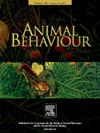Vertebrate decision making leads to the interdependence of behaviour and wellbeing
IF 2.3
2区 生物学
Q2 BEHAVIORAL SCIENCES
引用次数: 0
Abstract
Animal behaviour is commonly modelled by fitness-based optimization or individual-based simulation. Each has limitations: the premises for fitness-maximizing modelling are violated in most ecological and sociobiological settings while individual-based modelling generally does not include an evolutionary approach to behaviour. We propose a new approach focusing on the bodily mechanisms that vertebrates (and some other animals) use when making behavioural decisions. Our hypothesis is that decision making in vertebrates is a two-step process where emotion (a cognitive mechanism that for a while may become a state controlling the body and driving behaviour) is the common currency: (1) determining through competition among emotions the organism's current priority and (2) choosing the behaviour that maximizes imagined near-future emotional wellbeing, aided by episodic-like memory. Animals with subjective experience use awareness of their strongest emotional need to concentrate attention, which is a higher level of agency than the unconscious robustness mechanisms in all life forms. Furthermore, animals with imagination-based prediction maximize emotional wellbeing in their decision making. That is, evolution started out without a goal, but from it, animals that live for short-term wellbeing emerged. We show that wellbeing and other mechanisms of organismal robustness can be used in a new class of models that is broadly applicable to animals in natural and artificial settings. This modelling approach can make novel predictions about the links between wellbeing, behaviour and function.
脊椎动物的决策导致了行为和健康的相互依赖
动物行为通常通过基于适应度的优化或基于个体的模拟来建模。每一种模型都有其局限性:在大多数生态学和社会生物学环境中,都违反了适应度最大化模型的前提,而基于个体的模型通常不包括行为的进化方法。我们提出了一种新的方法,专注于脊椎动物(和其他一些动物)在做出行为决定时使用的身体机制。我们的假设是,脊椎动物的决策是一个两步过程,其中情绪(一种认知机制,在一段时间内可能成为控制身体和驱动行为的状态)是共同的货币:(1)通过情绪之间的竞争决定生物体当前的优先事项;(2)在情景记忆的帮助下,选择最大限度地提高近期情绪健康的行为。具有主观经验的动物利用意识到自己最强烈的情感需求来集中注意力,这是一种比所有生命形式的无意识鲁棒性机制更高层次的代理。此外,具有基于想象的预测能力的动物在决策时最大限度地提高了情绪幸福感。也就是说,进化开始时没有目标,但从它开始,为短期福利而生存的动物出现了。我们表明,健康和其他有机体稳健性机制可以用于一类新的模型,广泛适用于自然和人工环境中的动物。这种建模方法可以对健康、行为和功能之间的联系做出新颖的预测。
本文章由计算机程序翻译,如有差异,请以英文原文为准。
求助全文
约1分钟内获得全文
求助全文
来源期刊

Animal Behaviour
生物-动物学
CiteScore
4.60
自引率
8.00%
发文量
236
审稿时长
10.2 weeks
期刊介绍:
Growing interest in behavioural biology and the international reputation of Animal Behaviour prompted an expansion to monthly publication in 1989. Animal Behaviour continues to be the journal of choice for biologists, ethologists, psychologists, physiologists, and veterinarians with an interest in the subject.
 求助内容:
求助内容: 应助结果提醒方式:
应助结果提醒方式:


